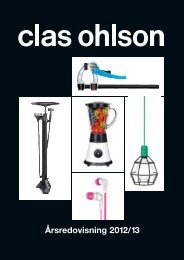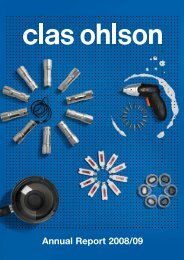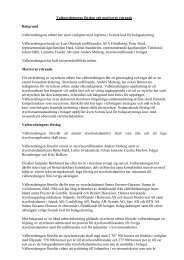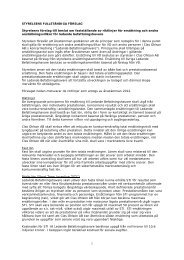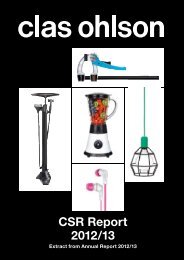Annual Report 2012/13 - Clas Ohlson
Annual Report 2012/13 - Clas Ohlson
Annual Report 2012/13 - Clas Ohlson
You also want an ePaper? Increase the reach of your titles
YUMPU automatically turns print PDFs into web optimized ePapers that Google loves.
Note 6 cont.<br />
Remuneration of Board members. managing directors and<br />
other senior management<br />
<strong>2012</strong>/<strong>13</strong> 2011/12<br />
Parent Company<br />
Salaries and other remuneration 25.1 28.0<br />
– of which variable remuneration 0.0 0.0<br />
Pension expenses 5.7 5.3<br />
Number of individuals in group 17 17<br />
<strong>2012</strong>/<strong>13</strong> 2011/12<br />
Group<br />
Salaries and other remuneration 31.5 34.6<br />
– of which variable remuneration 0.0 0.0<br />
Pension expenses 6.5 6.1<br />
Number of individuals in group 21 21<br />
Board remuneration<br />
Fees are paid to the members of the Board according to AGM resolutions.<br />
The fees are paid in the form of salary or by invoice. Board members who<br />
are employed in the company do not receive director fees. No pensions or<br />
other incentive programmes are paid to the company’s Board. No director<br />
fees were paid in the subsidiaries.<br />
The Board<br />
<strong>2012</strong>/<strong>13</strong> 2011/12<br />
Director<br />
fees<br />
Other<br />
remuneration<br />
Director<br />
fees<br />
Other<br />
remuneration<br />
Anders Moberg, Chairman 0.60 0.12 0.55 0.12<br />
Björn Haid, member 0.30 0.06 0.28 0.06<br />
Cecilia Marlow, member 0.30 0.07 0.28 0.07<br />
Sanna Suvanto-Harsaae, member 0.30 0.06 0.28 0.06<br />
Klas Balkow, member and CEO 0.00 0.00 0.00 0.00<br />
Lottie Svedenstedt, member 0.30 0.07 0.28 0.07<br />
Urban Jansson, member 0.30 0.14 0.28 0.14<br />
Edgar Rosenberger, member* 0.30 0.06 0.28 0.06<br />
Board total 2.40 0.58 2.20 0.58<br />
Board member Klas Balkow received remuneration in his capacity of President<br />
and CEO of the company.<br />
The gender distribution on the Board, among the members elected by<br />
the <strong>Annual</strong> General Meeting, during the financial year was five men and three<br />
women. In percentage terms, the distribution is thus 62.5 per cent male and<br />
37.5 per cent female. The distribution in the preceding year was the same.<br />
Remuneration to senior management<br />
Remuneration paid to the Chief Executive Officer and other members of senior<br />
management is made up of basic salary, variable remuneration and pension<br />
contributions. Other members of senior management are the eight individuals<br />
who together with the Chief Executive Officer and the Deputy CEO made up<br />
the Group management team during the financial year. For the composition<br />
of the senior management at 30 April 20<strong>13</strong>, see pages 82–83 of the printed<br />
annual report.<br />
<strong>2012</strong>/<strong>13</strong> 2011/12<br />
Basic Vari. remu. Benefits<br />
salary<br />
Salaries paid to<br />
senior management<br />
Vari. remu. Benefits<br />
Basic<br />
STI LTI 1 salary STI LTI 1<br />
Klas Balkow. CEO 4.6 1.1 0.0 0.2 4.3 1.3 0.8 0.2<br />
Deputy CEO 2.7 0.6 0.0 0.1 2.5 0.6 0.5 0.1<br />
Other senior<br />
management (8) 11.4 1.7 0.2 0.7 10.7 2.0 1.5 0.7<br />
Management total 18.7 3.4 0.2 1.0 17.5 3.9 2.8 1.0<br />
1<br />
LTI (Long term incentive program) pertains to a reported cost for LTI 2010, LTI 2011 and<br />
LTI <strong>2012</strong>. The amount includes the expensed portion of LTI 2011 and LTI <strong>2012</strong>, which was<br />
largely compensated by a reversed provision (reduced cost) for LTI 2010 since no stock<br />
options were allocated. Refer below to the description of STI (Short term incentive program)<br />
and LTI.<br />
Pension expenses for<br />
senior management<br />
<strong>2012</strong>/<strong>13</strong> 2011/12<br />
Definedcontribution<br />
Definedcontribution<br />
Definedbenefit<br />
Definedbenefit<br />
Klas Balkow, CEO 1.6 0.0 1.5 0.0<br />
Deputy CEO 0.7 0.0 0.7 0.0<br />
Other senior management<br />
(8) 3.4 0.0 3.1 0.0<br />
Management total 5.7 0.0 5.3 0.0<br />
Under the contract of employment with the Chief Executive Officer, the<br />
mutual period of notice is six months. Twelve months’ salary is payable<br />
should employment be terminated by the company. Applicable salary and<br />
benefits are payable during the period of notice. The retirement age is 65,<br />
and the current pension contribution is equivalent to SEK 1.6 M.<br />
Salary and other remuneration payable to the CEO are decided by the<br />
Board and prepared by the Remuneration Committee appointed within the<br />
Board. Salary is reviewed at the end of each calendar year.<br />
Salaries and other remuneration for other senior management are decided<br />
by the Chief Executive Officer, supported by the Remuneration Committee<br />
within the framework decided by the Board.<br />
The principles for variable remuneration are resolved by the AGM.<br />
The performance targets are prepared by the Remuneration Committee<br />
and decided by the Board. During the year, two different types of variable<br />
remuneration, STI and LTI, were payable.<br />
Provisions for STI and LTI are posted continuously in the individual annual<br />
accounts. All members of senior management are entitled to annual pension<br />
contributions, primarily in accordance with the ITP plan. The retirement age<br />
is 65 years.<br />
The gender distribution during the financial year among senior<br />
management of the Parent Company, and of the Group, is eight male and two<br />
female. In percentage terms, the distribution is thus 80 per cent male and 20<br />
per cent female, which is the same percentage as in the preceding year.<br />
Further information on decision-making processes in the Group is<br />
presented on pages 50–55 in the printed annual report.<br />
Remuneration principles:<br />
The general principles of remuneration for senior management are to<br />
be based on the position held, individual performance, the Group’s<br />
financial results and the remuneration being competitive in the country<br />
of employment. The combined remuneration of senior management is to<br />
consist of basic salary, variable salary in the form of a short-term incentive<br />
based on annual performance objectives, long-term incentives based on<br />
performance over several years, pension and other benefits. In addition,<br />
notice of termination and severance pay are subject to terms and conditions.<br />
<strong>Clas</strong> <strong>Ohlson</strong> aims to offer a competitive total level of remuneration, focusing<br />
on payments based on performance. This means that variable remuneration<br />
may comprise a significant portion of total remuneration. The aim is for<br />
fixed remuneration to be in line with the median of the comparable market,<br />
while total remuneration, when <strong>Clas</strong> <strong>Ohlson</strong> AB meets or exceeds its objectives,<br />
shall be in the upper quartile of the market.<br />
Basic salary<br />
The basic salary is to comprise the basis for total remuneration. The salary<br />
should be related to the relevant market and reflect the extent of the responsibilities<br />
included in the position. The basic salary is to be based on work performance<br />
and the degree to which the employee develops his/her expertise<br />
to assume future assignments with greater responsibility. The basic salary is<br />
to be reviewed annually to ensure that it is market-based and competitive.<br />
Variable salary (Short Term Incentive “STI”)<br />
In addition to basic salary, senior management are to qualify for STI for profits<br />
that exceed one or several predetermined performance levels during a<br />
financial year, designed to promote the company’s long-term value creation.<br />
Clearly defined performance targets are decided annually by the Board or<br />
by individuals elected by the Board. The performance targets may be connected<br />
to operational, financial or personal results. Remuneration from the<br />
STI plan is subject to a ceiling, which means that <strong>Clas</strong> <strong>Ohlson</strong> can calculate<br />
maximum remuneration levels from the beginning. Insofar as performance<br />
does not match the lowest performance level, no STI will be paid. STI will<br />
depend on the position and may not exceed 50 per cent of salary if the ceiling<br />
is achieved, which also represents the maximum outcome of STI. STI<br />
68<br />
Accounts




